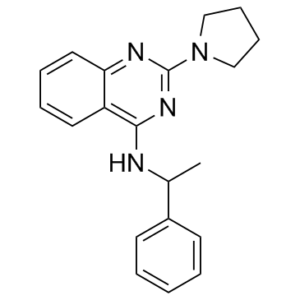Importazole is a 2,4-diaminoquinazoline that was found in a high-throughput small molecule screen for FRET-based compounds that interfere with the interaction between importin-β and RanGTP. Importazole is a small molecule inhibitor of the transport receptor importin-β that specifically prevents importin-β-mediated nuclear import. In vitro, it is a potent importin-β/Ran interaction inhibitor. Importazole specifically prevents importin-β-mediated nuclear import from occurring in both Xenopus egg extracts and cultured cells, while leaving transportin- and CRM1-mediated nuclear import and export unaffected. Importazole interferes with the release of an importin-β-cargo FRET probe and leads to both anticipated and unanticipated defects in spindle assembly when added during mitosis. Importazole is a useful tool for assessing the role of the importin-β-/RanGTP pathway at particular cell cycle stages.
Physicochemical Properties
| Molecular Formula | C20H22N4 | |
| Molecular Weight | 318.42 | |
| Exact Mass | 318.184 | |
| Elemental Analysis | C, 75.44; H, 6.96; N, 17.60 | |
| CAS # | 662163-81-7 | |
| Related CAS # | 662163-81-7;Importazole HCl; | |
| PubChem CID | 2949965 | |
| Appearance | White to off-white solid powder | |
| Density | 1.2±0.1 g/cm3 | |
| Boiling Point | 516.8±42.0 °C at 760 mmHg | |
| Flash Point | 266.3±27.9 °C | |
| Vapour Pressure | 0.0±1.3 mmHg at 25°C | |
| Index of Refraction | 1.682 | |
| LogP | 3.3 | |
| Hydrogen Bond Donor Count | 1 | |
| Hydrogen Bond Acceptor Count | 4 | |
| Rotatable Bond Count | 4 | |
| Heavy Atom Count | 24 | |
| Complexity | 389 | |
| Defined Atom Stereocenter Count | 0 | |
| SMILES | CC(NC1=C2C=CC=CC2=NC(N3CCCC3)=N1)C4=CC=CC=C4 |
|
| InChi Key | HKGJEZIGDHFJFL-UHFFFAOYSA-N | |
| InChi Code | InChI=1S/C20H22N4/c1-15(16-9-3-2-4-10-16)21-19-17-11-5-6-12-18(17)22-20(23-19)24-13-7-8-14-24/h2-6,9-12,15H,7-8,13-14H2,1H3,(H,21,22,23) | |
| Chemical Name | N-(1-phenylethyl)-2-pyrrolidin-1-ylquinazolin-4-amine | |
| Synonyms |
|
|
| HS Tariff Code | 2934.99.9001 | |
| Storage |
Powder-20°C 3 years 4°C 2 years In solvent -80°C 6 months -20°C 1 month |
|
| Shipping Condition | Room temperature (This product is stable at ambient temperature for a few days during ordinary shipping and time spent in Customs) |
Biological Activity
| Targets | importin-β | ||
| ln Vitro | In vitro, importazole is a potent inhibitor of the Ran/importin-β interaction. Importazole specifically prevents importin-β-mediated nuclear import from occurring in both Xenopus egg extracts and cultured cells, without disrupting transportin-mediated nuclear import or CRM1-mediated nuclear export. Importazole interferes with the release of an importin-β cargo FRET probe and leads to both anticipated and unanticipated defects in spindle assembly when added during mitosis[1]. By blocking the NF-κB signal pathway in vitro, it also prevents multiple myeloma cells from proliferating and causes them to undergo apoptosis[2]. | ||
| ln Vivo |
|
||
| Enzyme Assay | Importazole, a 2,4-diaminoquinazoline identified from a FRET-based, high-throughput small molecule screen for compounds that interfere with the interaction between RanGTP and importin-β, is a small molecule inhibitor of the transport receptor importin-β that specifically blocks importin-β-mediated nuclear import. It is an effective inhibitor of the Ran/importin-β interaction in vitro. | ||
| Cell Assay | HEK 293 cells stably expressing NFAT-GFP are grown on glass coverslips to approximately 50% confluency prior to drug treatment. Leptomycin B is administered at 10 ng/mL and importazole is always used at a concentration of 40 M. A 0.4% concentration of DMSO is used as a control. 1.25 μM of ionomycin is added. Treatments with importazole and leptomycin B last an hour each. Prior to fluorescence microscopy, cells are fixed with 4% formaldehyde in all experiments. With 1 g/mL Hoechst dye, DNA is seen. The percentage of 100 cells from each condition that exhibit nuclear accumulation of NFAT-GFP is calculated[1] for quantification. | ||
| Animal Protocol |
|
||
| References |
[1]. ACS Chem Biol . 2011 Jul 15;6(7):700-8. [2]. Zhonghua Xue Ye Xue Za Zhi . 2013 Apr;34(4):323-6. |
||
| Additional Infomation | N-(1-phenylethyl)-2-(1-pyrrolidinyl)-4-quinazolinamine is a member of quinazolines. |
Solubility Data
| Solubility (In Vitro) |
|
|||
| Solubility (In Vivo) |
Solubility in Formulation 1: ≥ 2.5 mg/mL (7.85 mM) (saturation unknown) in 10% DMSO + 40% PEG300 + 5% Tween80 + 45% Saline (add these co-solvents sequentially from left to right, and one by one), clear solution. For example, if 1 mL of working solution is to be prepared, you can add 100 μL of 25.0 mg/mL clear DMSO stock solution to 400 μL PEG300 and mix evenly; then add 50 μL Tween-80 to the above solution and mix evenly; then add 450 μL normal saline to adjust the volume to 1 mL. Preparation of saline: Dissolve 0.9 g of sodium chloride in 100 mL ddH₂ O to obtain a clear solution. Solubility in Formulation 2: ≥ 2.5 mg/mL (7.85 mM) (saturation unknown) in 10% DMSO + 90% Corn Oil (add these co-solvents sequentially from left to right, and one by one), clear solution. For example, if 1 mL of working solution is to be prepared, you can add 100 μL of 25.0 mg/mL clear DMSO stock solution to 900 μL of corn oil and mix evenly. (Please use freshly prepared in vivo formulations for optimal results.) |
| Preparing Stock Solutions | 1 mg | 5 mg | 10 mg | |
| 1 mM | 3.1405 mL | 15.7025 mL | 31.4051 mL | |
| 5 mM | 0.6281 mL | 3.1405 mL | 6.2810 mL | |
| 10 mM | 0.3141 mL | 1.5703 mL | 3.1405 mL |
